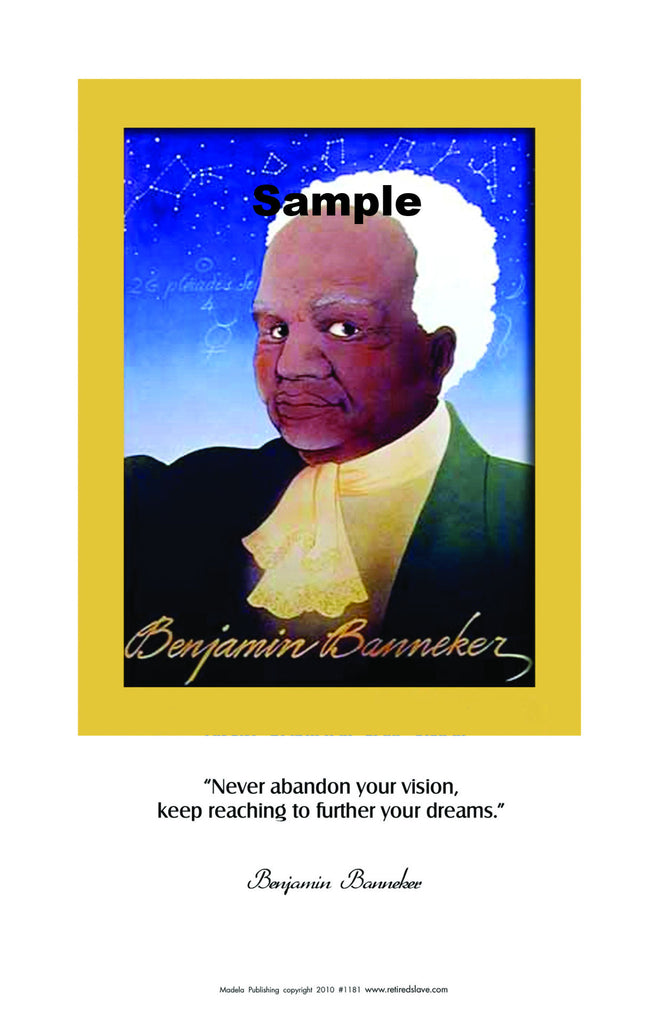Benjamin Banneker #1181
$ 10.00
Caption from poster__
" Never abandon your vision
Keep reaching to further your dreams."
he worked on ephemeris and Almanac. At a relatively young age Benjamin Banneker made a clock carved using raw wood, many admirers still consider it as one of Benjamin's finest work of innovation. Benjamin Banneker was also an ardent supporter of racial equality. Benjamin Banneker was born at Baltimore, Maryland on November 9, 1731. He was son of Robert and Mary, Benjamin inherited keen interest in astronomy from his grandfather, Banneka. Benjamin Banneker’s grandmother taught him to read write, she also equipped the young Benjamin with elementary knowledge of the sky. During the course of his life Benjamin met Peter Heinrichs who helped Benjamin further in his academic pursuits by sharing his personal library with him. When Benjamin became old enough, he started to work on his family farm to sustain himself financially, this lead to a temporary halt in his educational endeavors. Displaying the traits of an innovative inventor Benjamin carved a wooden clock which efficiently kept record of hours, this clock worked well till his death in 1806. In 1771, a white Quaker family named Ellicotts moved to the bank of Patapsco River and built a mill over there. Benjamin used to supply food to the workers of the mill and over a period of time he developed a friendly relationship with George Ellicott. Benjamin again resumed his study in 1778 with the help of George who provided books and equipments to help Banneker in his study. Recognizing Benjamin’s acumen Andrew Ellicott one of the relatives of George employed Benjamin Banneker to help him survey 260 km boundary of federal district. The scope of his work consists of making astronomical observations at Alexandria, Virginia for locating starting points of the survey. Employing his knowledge of sky Benjamin was able to relate the points on the surface to the position of stars, with the help of his improvised clock. Due to ailing health Benjamin had to quit the survey project for an indefinite period in 1791. Benjamin returned to his home and continued his work on ephemeris. He calculated the occurrences of solar and lunar eclipses and latter he added them to Benjamin Banneker's Almanac. In those days Thomas Jefferson was the Secretary of State who played critical role in forming Declaration of Independence. Banneker pleaded to Thomas Jefferson for justice from slavery and also included his ephemeris to strengthen his plea. Jefferson also showed his interest towards race equality and he forwarded Banneker's Almanac to French Academy and also to Britain’s House of commons. His almanac plans where also included at the department of peace. Legends described Banneker as a man who served and helped in the finalizing the layout for the establishment of some of the major government buildings like 16th Street Meridian, White House and Treasury Building. Many people disagree to this theory by giving full credit to L'Enfant for finalizing the layout of these important buildings. A museum was opened for public in 2008 and it marked Banneker as assistant to chief surveyor in laying out of the plan based on Pierre L’Enfant’s Plan. Benjamin Banneker never married and died in his cabin on October 9, 1806. Through out his life, he unequivocally advocated for race equality and did a remarkable job in the field of astronomy. United States postal service issued a stamp on February 15, 1980 with his portrait on it. On June 9, 1998, a park was dedicated to his memories. The park also has a museum which displays his important works and is a major attraction for the tourists.




